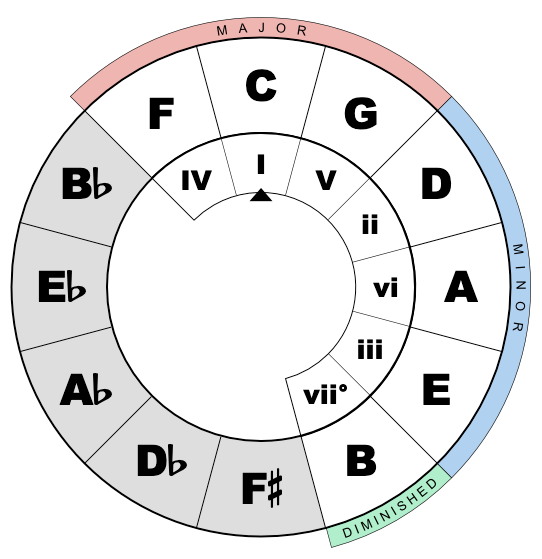The Ninth Chords

In this lesson, we will learn about major and minor ninth chords. In previous lessons, you studied triads and four-note chords (triads and seventh chords). Here, we will explore five-note chords called ninth chords.
| Number of Keys | Chord Type |
|---|---|
| 3 | Triad |
| 4 | Seventh Chord |
| 5 | Ninth Chord |
| 6 | Eleventh Chord |
| 7 | Thirteenth Chord |
A major ninth chord refers to a chord that adds a note beyond the octave (the eighth note).
Thus, a major ninth chord is formed by adding the ninth note to a major seventh chord.
For example, in C major, the ninth note is D.
default:
Piano.Keyboard: Em7/C
Personally, I prefer embedding the ninth note within the chord structure:
default:
Piano.Keyboard: G6/C
You can create a major ninth chord by playing the iii minor seventh chord above the root note in the bass. For instance, to form a Cmaj9 chord, take the iii note (E) and build an Emin7 chord over the root C (in the bass).
default:
Piano.Keyboard: Em7/C
As shown in the diagram below, this connects to the concepts we covered in Lesson 10.
Maj6= Min7
Major 9th Chords:
Minor Ninth Chords
A minor ninth chord, simply put, adds a ninth interval to a minor seventh chord. You can also remember this rule:
Root + Relative Major Seventh Chord = Minor Ninth Chord
For example, in C minor, the relative major key is E major. By adding an E major seventh chord above the root C (in the bass), you form a Cmin9 chord.
default:
Piano.Chart: Cm9
Personally, I prefer embedding the ninth note within the chord structure when playing ninth chords:

Minor Ninth Chord Reference Diagram
default:
Piano.Chart: m9
Dominant Ninth Chords
A dominant ninth chord is formed by combining a dominant seventh chord with an added ninth note. These are typically labeled as "dom9" or simply "9" chords.
A dominant ninth chord consists of a dominant seventh chord plus the ninth note.
Alternatively, it can be remembered using this formula:
Root + iii Half-Diminished Seventh Chord = Dominant Ninth Chord
For example, a dominant ninth chord in C major is written as C9 and includes the notes C, E, G, B♭, and D. It contains the root, major third, perfect fifth, minor seventh, and ninth of the C major scale.

Personally, I prefer embedding the ninth note within the middle of the chord structure.

Notice the pattern?
This relates to the connection between minor sixth and half-diminished seventh chords from Lesson 10:
Min6 = Min7♭5
Dominant Ninth Chord Reference Diagram

Dominant 9th chord with added sixth note
By adding the sixth note of the scale to the D9 chord, a D9/6 chord is formed.

It is usually played like this:

By simply switching from the minor ninth chord to the IV9/6 chord, the entire circle of fifths chart can be played.


Here is the inversion of F9/6, which is easiest to play after Cmin9:

Notice that the only difference between Cmin9 and F9/6 is one note (the seventh is lowered a semitone in the same way, changing from C major to F major).

This pattern continues until you get back to the Cmin9 chord. That is, alternate between Min 9 and Dom9/6 chords.
Remember: After playing a min9 chord, just lower the seventh to play the next dom9/6 chord. In fact, you only need to know the min9 chord because the next chord is formed by lowering the seventh by a half tone. Also, practicing from Cmin only covers half of the min9 chord, since the other half is the dom9/6 chord. To play the other half of the min9 chord, choose the Fmin9/6 chord when you start practicing.
Tip: You only need to use four fingers of your right hand. The tonic should be played in the bass part. I personally recommend using the third inversion of the min9 chord. I use this inversion all the time, and it is easier to play and remember than the root inversion of the min9 chord. It also creates a "full" sound by playing the seventh at the bottom. Also, since the seventh is the lowered note, it is easier to remember to lower the lowest note of the chord rather than the note in the middle of the chord.

Note that the Cmin9 (3rd inversion) chord is also the Ebmaj7 (2nd inversion) chord, just without the "C" as the bass.
min9 = relative major seventh chord
By simply lowering the seventh note (the lowest note in the third inversion), the next dom9/6 chord is formed.

Resolve to IV9 using a min9 ➔ 9 ➔ 6 chord.
In blues and gospel music, the I, IV, and V chords are most likely to be dominant sevenths, dominant ninths, or dominant thirteens (not yet learned). In the previous chapter, you learned the progression I ➔ IV.
This example will show you how to insert "min9 ➔ 9 / 6" into the chord progression I ➔ IV.
ii - V - I with IV Chords
The IV chord is not a tonic (I) chord, as there can only be one tonic chord in any given key. However, it can function as an "I" chord in various situations. That is, it can briefly become an I chord, and the I chord can become a dominant chord. The best way to do this is to simply play the "2 - 5 - 1" chord progression with the IV chord.
Here is an example in the key of C major:

In the key of C major, F is the IV note.
Here is the "ii - V - I" chord progression over the F chord:

Now, replace it with the corresponding min9 ➔ 9/6 chord:
Gmin9 ➔ C9/6 ➔ F9
Here are examples using this progression:
Example 1:
Key signature: F major
Chord progression: C9 ➔ Gmin9 ➔ C9/6 ➔ Fmaj9
In this example, the ii chord (Gmin9) is followed by the V chord (C9/6) and finally resolves to the I chord (FMaj9).

Example 2:
Key Signature: C Major
Chord Progression: Dmin9 ➔ G9/6 ➔ CMaj9
In this example, the ii chord (Dmin9) is followed by the V chord (G9/6) and resolves to the I chord (CMaj9).
Example 3:
Key Signature: Bb Major
Chord Progression: Cmin9 ➔ F9/6 ➔ Bbmaj9
In this example, the ii chord (Cmin9) is followed by the V chord (F9/6) and resolves to the I chord (Bbmaj9).
These examples show how the "ii - V - I" progression using the min9 ➔ 9/6 chords gives the entire progression a unique and interesting sound.
iii ➔ Vi ➔ ii ➔ V ➔ I with chord IV
The previous chord progression can be extended by adding the iii ➔ vi chord progression:

Now, substitute the corresponding minor ninth chord and 9/6 chord:
Amin9 ➔ D9/6 ➔ Gmin9 ➔ C9/6 ➔ F9
NOTE: Remember that we are still in the key of C major. The IV chord plays the role of the I chord in this progression. In most songs, the chords eventually return to the tonic chord of "I".

Replace Min9 with Min7 Chords
I personally like to use Min9 chords in the 2 ➔ 5 ➔ 1 progression. Min9 chords not only sound fuller, but also produce a more beautiful tone. In the previous chapter, you have learned that the ii min7 chord is a preparatory chord for the V7 chord, and the V7 chord returns to the tonic (I) maj7 chord.

This progression can also be played using the ii min9, V9, and I maj9 chords:

I9 ➔ IV 9 Cycle
This chord progression is played frequently in blues and gospel music. It is often used at the end of "fast tempo" hymns.
In the key of C major, the I9 chord is C9 and the IV9 chord is F9. I prefer to use the C9 chord in the third inversion and the F9 chord in the second inversion. This combination produces the smoothest transition.

When transitioning to the IV9 chord, it is common to have the bass line gradually ascend. This can be done by playing a chromatic scale starting at the ii note on the bass line (to lead up to the IV chord), and then playing a chromatic scale starting at the vi note back to the I chord.
A chromatic scale is a scale made up of consecutive semitones. On a keyboard, all the keys in a row can be used.
So when transitioning to the IV9 chord, just play every key from the ii note to the IV note on the bass line. When transitioning back from the IV9 chord to the I chord, play every key from the vi note to the I note.
Here is an example in the key of C major:
Bass: C(C9) ➔ D ➔ Eb ➔ E ➔ F(F9) ➔ A ➔ Bb ➔ B ➔ C(C9) ➔
… and so on ➔ C9 ➔ F9
Note: This progression can be repeated indefinitely (depending on the nature of the song). This technique is often referred to as "Walking the bass".






